2023 年黑龙江高考英语真题及答案
本试卷共 12 页。考试结束后, 将本试卷和答题卡一并交回。
注意事项: 1. 答题前, 考生先将自己的姓名、准考证号码填写清楚, 将条形码准确粘贴在
考生信息条形码粘贴区。
2. 选择题必须使用 2B 铅笔填涂; 非选择题必须使用 0.5 毫米黑色字迹的签字笔书写, 字
体工整、笔迹清楚。
3. 请按照题号顺序在答题卡各题目的答题区域内作答, 超出答题区域书写的答案无效;
在草稿纸、试卷上答题无效。
4. 作图可先使用铅笔画出, 确定后必须用黑色字迹的签字笔描黑。
5. 保持卡面清洁, 不要折叠, 不要弄破、弄皱, 不准使用涂改液、修正带、刮纸刀。
第一部分 听力(1-20 小题)在笔试结束后进行。
第二部分 阅读(共两节, 满分 50 分)
第一节(共 15 小题; 每小题 2.5 分, 满分 37.5 分)
阅读下列短文,从每题所给的 A、B、C、D 四个选项中选出最佳选项。
A
Yellowstone National Park offers a variety of ranger programs throughout the
park, and throughout the year. The following are descriptions of the ranger programs
this summer.
Experiencing Wildlife in Yellowstone (May 26 to September 2)
Whether you’re hiking a backcountry trail (小径), camping, or just enjoying
the park’s amazing wildlife from the road, this quick workshop is for you and your
family. Learn where to look for animals and how to safely enjoy your wildlife watching
experience. Meet at the Canyon Village Store.
Junior Ranger Wildlife Olympics (June 5 to August 21)
Kids can test their skills and compare their abilities to the animals of
Yellowstone. Stay for as little or as long as your plans allow. Meet in front of
the Visitor Education Center.
Canyon Talks at Artist Point (June 9 to September 2)
From a classic viewpoint, enjoy Lower Falls, the Yellowstone River, and the
�
breathtaking colors of the canyon (峡谷) while learning about the area’s natural
and human history. Discover why artists and photographers continue to be drawn to
this special place. Meet on the lower platform at Artist Point on the South Rim Drive
for this short talk.
Photography Workshops (June 19 &July 10)
Enhance your photography skills — join Yellowstone’s park photographer for
a hands-on program to inspire new and creative ways of enjoying the beauty and wonder
of Yellowstone.
6/19 — Waterfalls &Wide Angles: meet at Artist Point.
7/10 — Wildflowers &White Balance: meet at Washburn Trailhead in Chittenden
parking area.
1. Which of the four programs begins the earliest?
A. Photography Workshops.
B. Junior Ranger Wildlife
Olympics.
C. Canyon Talks at Artist Point.
D. Experiencing Wildlife in
Yellowstone.
2. What is the short talk at Artist Point about?
A. Works of famous artists.
B. Protection of wild animals.
C. Basic photography skills.
D. History of the canyon area.
3. Where will the participants meet for the July 10 photography workshop?
A. Artist Point.
B. Washburn Trailhead.
C. Canyon Village Store.
D. Visitor Education Center.
B
Turning soil, pulling weeds, and harvesting cabbage sound like tough work for
middle and high school kids. And at first it is, says Abby Jaramillo, who with another
teacher started Urban Sprouts, a school garden program at four low-income schools.
The program aims to help students develop science skills, environmental awareness,
and healthy lifestyles.
Jaramillo’s students live in neighborhoods where fresh food and green space
are not easy to find and fast food restaurants outnumber grocery stores. “The kids
�
literally come to school with bags of snacks and large bottles of soft drinks,”
she says. “They come to us thinking vegetables are awful, dirt is awful, insects
are awful.” Though some are initially scared of the insects and turned off by the
dirt, most are eager to try something new.
Urban Sprouts’ classes, at two middle schools and two high schools, include
hands-on experiments such as soil testing, flower-and-seed dissection, tastings of
fresh or dried produce, and work in the garden. Several times a year, students cook
the vegetables they grow, and they occasionally make salads for their entire schools.
Program evaluations show that kids eat more vegetables as a result of the classes.
“We have students who say they went home and talked to their parents and now they’
re eating differently,” Jaramillo says.
She adds that the program’s benefits go beyond nutrition. Some students get
so interested in gardening that they bring home seeds to start their own vegetable
gardens. Besides, working in the garden seems to have a calming effect on Jaramillo’
s special education students, many of whom have emotional control issues. “They
get outside,” she says, “and they feel successful.”
4. What do we know about Abby Jaramillo?
A. She used to be a health worker.
B. She grew up in a low-income
family.
C. She owns a fast food restaurant.
D. She is an initiator of Urban
Sprouts.
5. What was a problem facing Jaramillo at the start of the program?
A. The kids’ parents distrusted her.
B. Students had little time for her
classes.
C. Some kids disliked garden work.
D. There was no space for school
gardens.
6. Which of the following best describes the impact of the program?
A. Far-reaching.
C. Short-lived.
B. Predictable.
D. Unidentifiable.
7. What can be a suitable title for the text?
�
A. Rescuing School Gardens
B. Experiencing Country Life
C. Growing Vegetable Lovers
D. Changing Local Landscape
C
ReadingArt:ArtforBookLoversis a celebration of an everyday object — the
book, represented here in almost three hundred artworks from museums around the world.
The image of the reader appears throughout history, in art made long before books
as we now know them came into being. In artists’ representations of books and reading,
we see moments of shared humanity that go beyond culture and time.
In this “book of books,” artworks are selected and arranged in a way that
emphasizes these connections between different eras and cultures. We see scenes of
children learning to read at home or at school, with the book as a focus for relations
between the generations. Adults are portrayed (描绘) alone in many settings and poses
—absorbed in a volume, deep in thought or lost in a moment of leisure. These scenes
may have been painted hundreds of years ago, but they record moments we can all relate
to.
Books themselves may be used symbolically in paintings to demonstrate the
intellect (才智), wealth or faith of the subject. Before the wide use of the printing
press, books were treasured objects and could be works of art in their own right.
More recently, as books have become inexpensive or even throwaway, artists have used
them as the raw material for artworks — transforming covers, pages or even complete
volumes into paintings and sculptures.
Continued developments in communication technologies were once believed to make
the printed page outdated. From a 21st-century point of view, the printed book is
certainly ancient, but it remains as interactive as any battery-powered e-reader.
To serve its function, a book must be activated by a user: the cover opened, the
pages parted, the contents reviewed, perhaps notes written down or words underlined.
And in contrast to our increasingly networked lives where the information we consume
is monitored and tracked, a printed book still offers the chance of a wholly private,
“off-line” activity.
8. Where is the text most probably taken from?
�
A. An introduction to a book.
B. An essay on the art of writing.
C. A guidebook to a museum.
9. What are the selected artworks about?
D. A review of modern paintings.
A. Wealth and intellect.
B. Home and school.
C. Books and reading.
D. Work and leisure.
10. What do the underlined words “relate to” in paragraph 2 mean?
A. Understand.
C. Seize.
B. Paint.
D. Transform.
11. What does the author want to say by mentioning the e-reader?
A. The printed book is not totally out of date.
B. Technology has changed the way we read.
C. Our lives in the 21st century are networked.
D. People now rarely have the patience to read.
D
As cities balloon with growth, access to nature for people living in urban areas
is becoming harder to find. If you’re lucky, there might be a pocket park near where
you live, but it’s unusual to find places in a city that are relatively wild.
Past research has found health and wellness benefits of nature for humans, but
a new study shows that wildness in urban areas is extremely important for human
well-being.
The research team focused on a large urban park. They surveyed several hundred
park-goers, asking them to submit a written summary online of a meaningful
interaction they had with nature in the park. The researchers then examined these
submissions, coding (编码) experiences into different categories. For example, one
participant’s experience of “We sat and listened to the waves at the beach for
awhile” was assigned the categories “sitting at beach” and “listening to waves.”
Across the 320 submissions, a pattern of categories the researchers call a
“nature language” began to emerge. After the coding of all submissions, half a
dozen categories were noted most often as important to visitors. These include
�
encountering wildlife, walking along the edge of water, and following an established
trail.
Naming each nature experience creates a usable language, which helps people
recognize and take part in the activities that are most satisfying and meaningful
to them. For example, the experience of walking along the edge of water might be
satisfying for a young professional on a weekend hike in the park. Back downtown
during a workday, they can enjoy a more domestic form of this interaction by walking
along a fountain on their lunch break.
“We’re trying to generate a language that helps bring the human-nature
interactions back into our daily lives. And for that to happen, we also need to
protect nature so that we can interact with it,” said Peter Kahn, a senior author
of the study.
12. What phenomenon does the author describe at the beginning of the text?
A. Pocket parks are now popular.
B. Wild nature is hard to find in
cities.
C. Many cities are overpopulated.
D. People enjoy living close to
nature.
13. Why did the researchers code participant submissions into categories?
A. To compare different types of park-goers.
B. To explain why the park attracts
tourists.
C. To analyze the main features of the park.
D. To find patterns in the
visitors’ summaries.
14. What can we learn from the example given in paragraph 5?
A. Walking is the best way to gain access to nature.
B. Young people are too busy to interact with nature.
C. The same nature experience takes different forms.
D. The nature language enhances work performance.
15. What should be done before we can interact with nature according to Kahn?
A. Language study.
B. Environmental conservation.
C. Public education.
D. Intercultural communication.
�
第二节(共 5 小题; 每小题 2.5 分, 满分 12.5 分)
阅读下面短文, 从短文后的选项中选出可以填入空白处的最佳选项。选项中有两项为多余
选项。
As an artist who shares her journey on social media, I’m often asked by curious
followers how to begin an art journey. Unfortunately, there is no magic list I can
offer. I do remember, though, what it was like to be a complete beginner. So I’
ve put together some good tips for starting an art journey.
·Start small. I suggest using a sketchbook (素描本) for small studies. These
small studies provide inspiration and may be a springboard for more complex works
in the future. ___16___ You’ll want to look back on your journey to see how far
you’ve come.
·Paint often and paint from life. There’s no better way to improve than to
put in those brush miles. Whether you paint still lifes, portraits, or landscapes,
paint from life as much as possible. ___17___
·Continually challenge yourself to try something new. ___18___ Artistic growth
can be a bit painful. Welcome to the club;we’ve all been there. I love taking on
challenges. I once took up a challenge to create a painting every day for a month
and post the works online.
·___19___ Seeking and accepting constructive feedback (反馈) is crucial to
growth. I post my work on social media and, in turn, have met some of the kindest
people. They make me feel valued and respected, no matter my level of artistic
ability.
The journey you’re on won’t follow a straight path. ___20___ Push through,
give it time and put in the effort. You will harvest the rewards of an artistic life.
A. Get out of your comfort zone.
B. Make career plans and set goals.
C. Don’t throw away your beginner art.
D. Share your work if you feel comfortable doing so.
E. You’ll hit roadblocks, and you’ll feel discouraged at times.
F. Evaluate your performance and, if needed, redefine your role.
�
G. You’ll develop that painting muscle memory that only comes with repetition.
第三部分语言运用(共两节, 满分 30 分)
第一节(共 15 小题; 每小题 1 分, 满分 15 分)
阅读下面短文, 从每题所给的 A、B、C、D 四个选项中选出可以填入空白处的最佳选项。
In April last year, I saw a post on the PNP (Pilots N Paws) website from a family
in Topeka. They had to move to Virginia but they were on a very tight ___21___. They
could not afford to pay for ___22___ for their dog, Tiffy, and ___23___ wanted to
take her with them.
It just ___24___ that I was planning another PNP flight with another pilot, Karen,
who ___25___ to take Tiffy from Kansas City to Virginia. What I was to do was fly
to Topeka to ___26___ Tiffy.
When I met Tiffy’s owners, they seemed very ___27___. George, the husband, was
trying to be calm, but I could tell this was ___28___ for him, having to leave his
dog to a ___29___ and trust that everything would _____30_____.
After some goodbyes, I asked George and his wife to help me _____31_____ Tiffy
into the plane. I promised to take care of Tiffy and _____32_____ them as soon as
we got to Kansas City.
The flight was _____33_____, and Tiffy was a great passenger. The next day, she
_____34_____ with Karen and made it back to George in Virginia within a few days.
He was so _____35_____ and sent me a nice e-mail with pictures. It felt great to
know that I had helped bring this family together again.
21. A. turn
B. budget
C. schedule
connection
22. A. food
B. shelter
C. medicine
transportation
23. A. desperately
B. temporarily
C. secretly
originally
D.
D.
D.
24. A. appeared
B. proved
C. happened
25. A. waited
B. offered
C. hurried
D. showed
D. failed
26. A. see off
B. look for
C. hand over
D. pick up
�
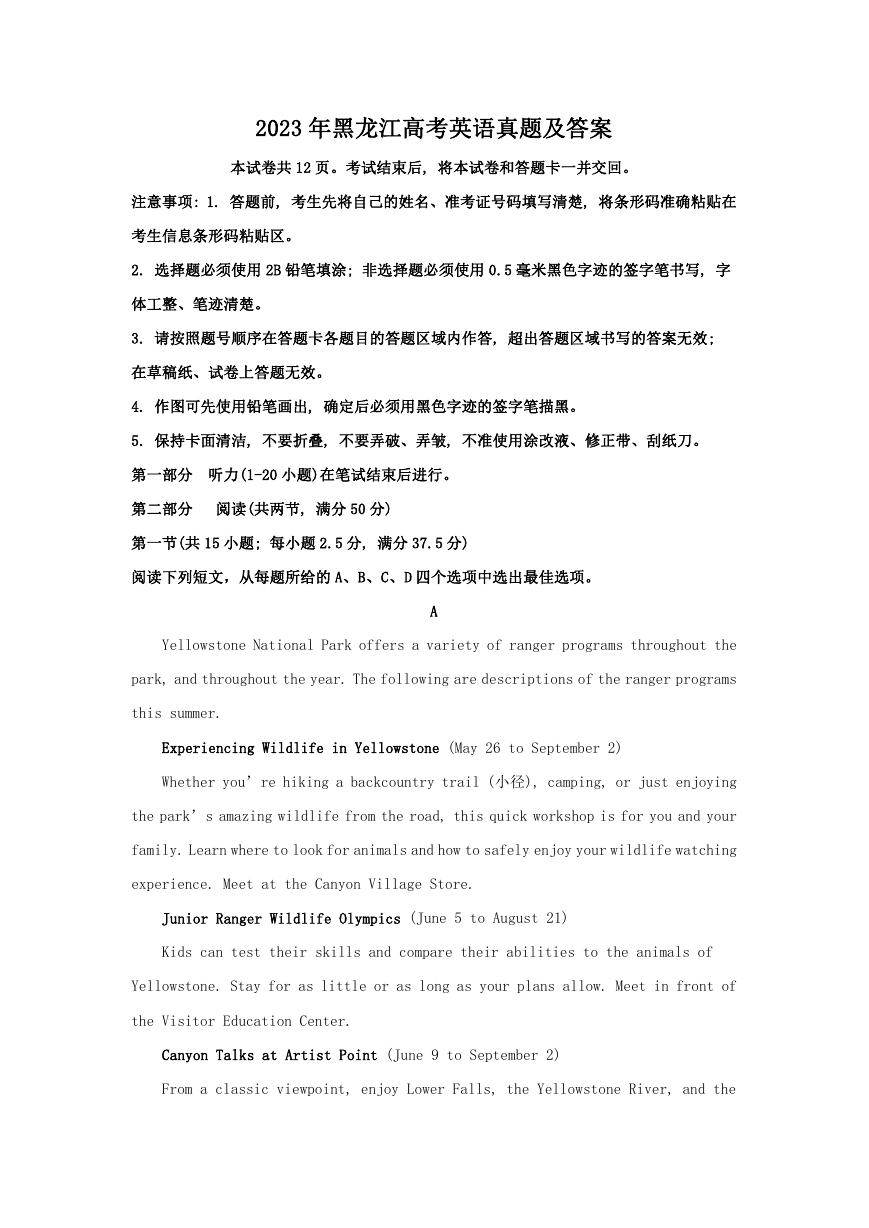


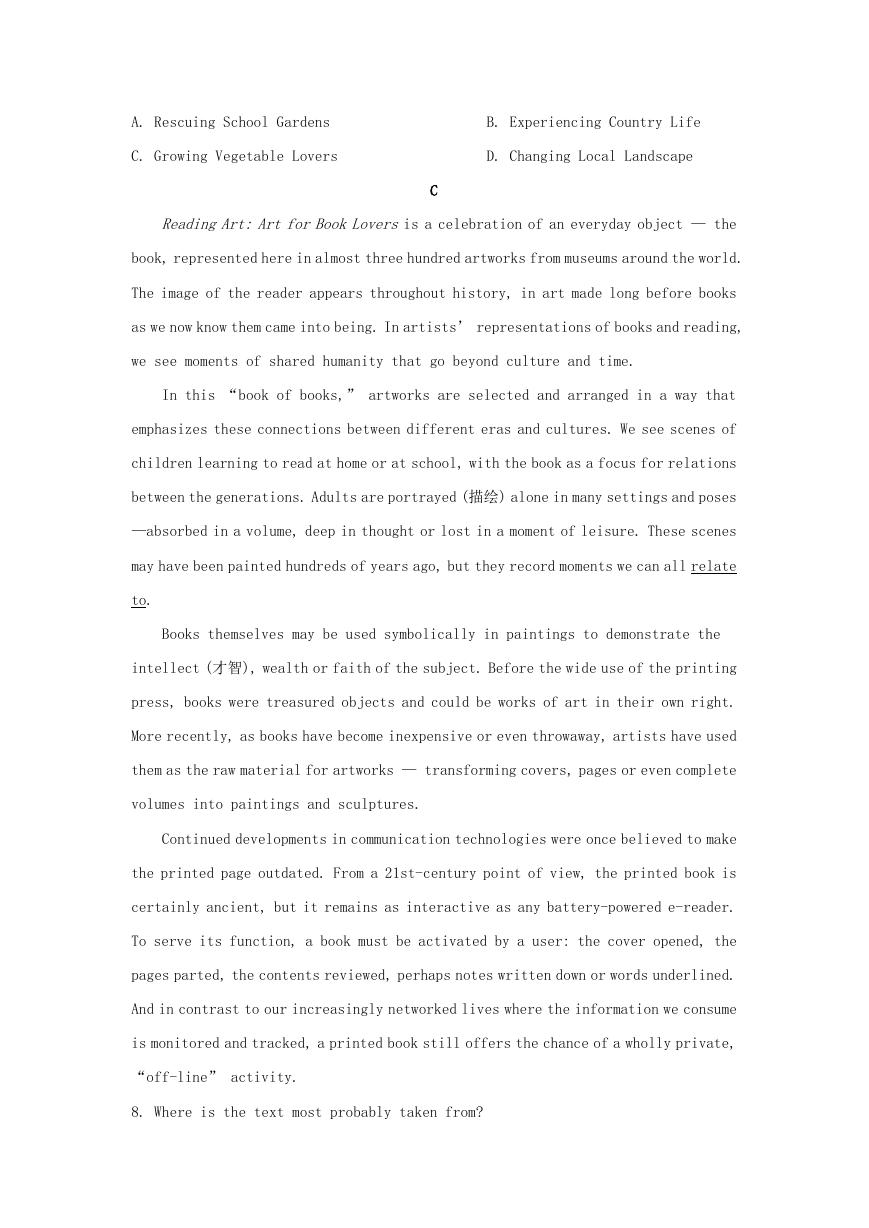
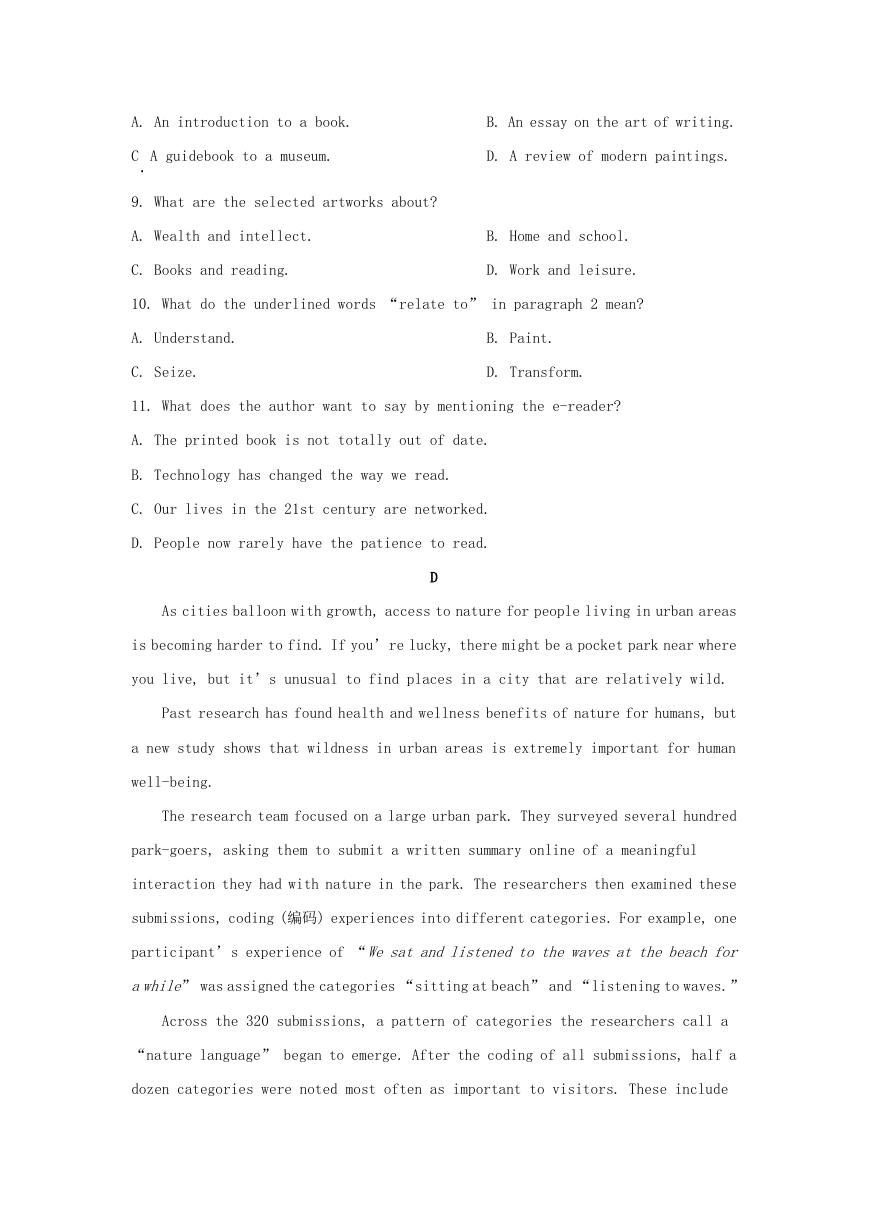
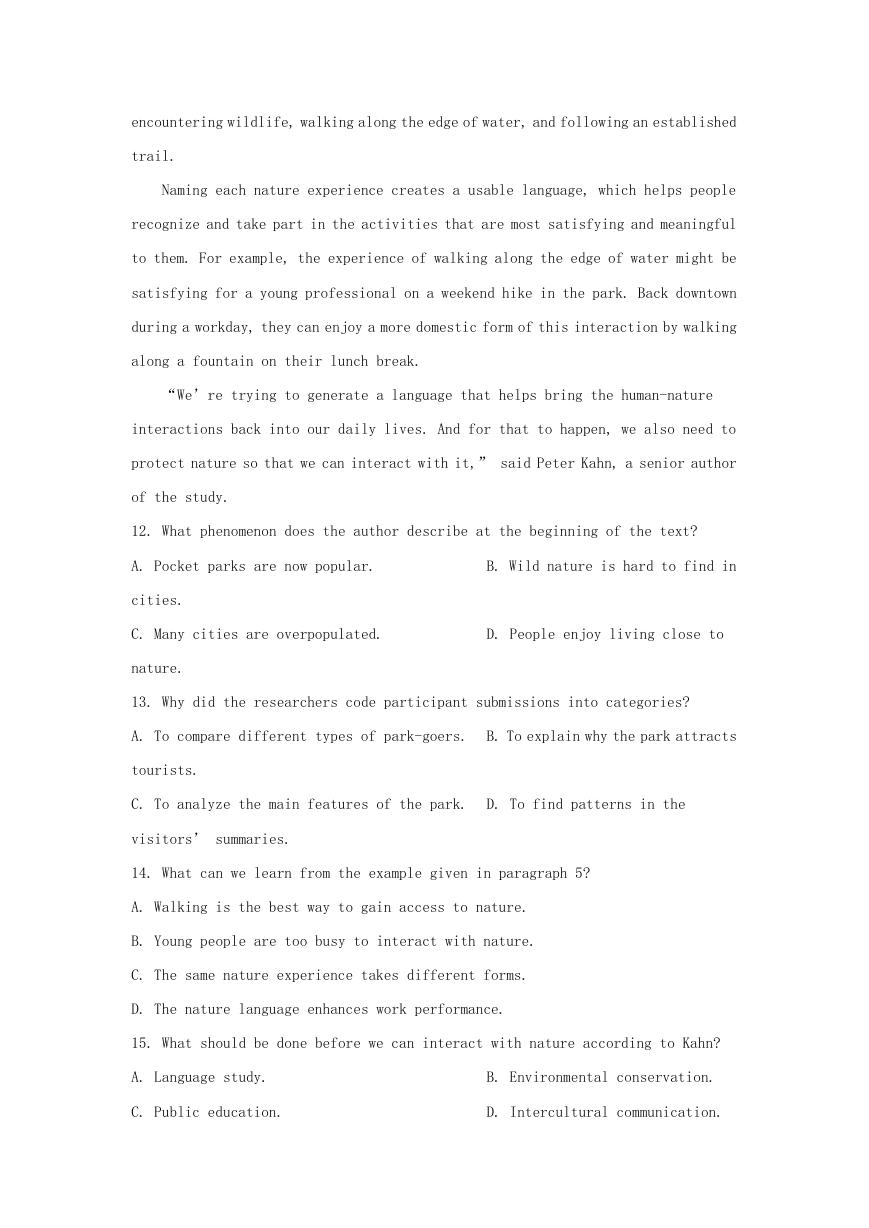
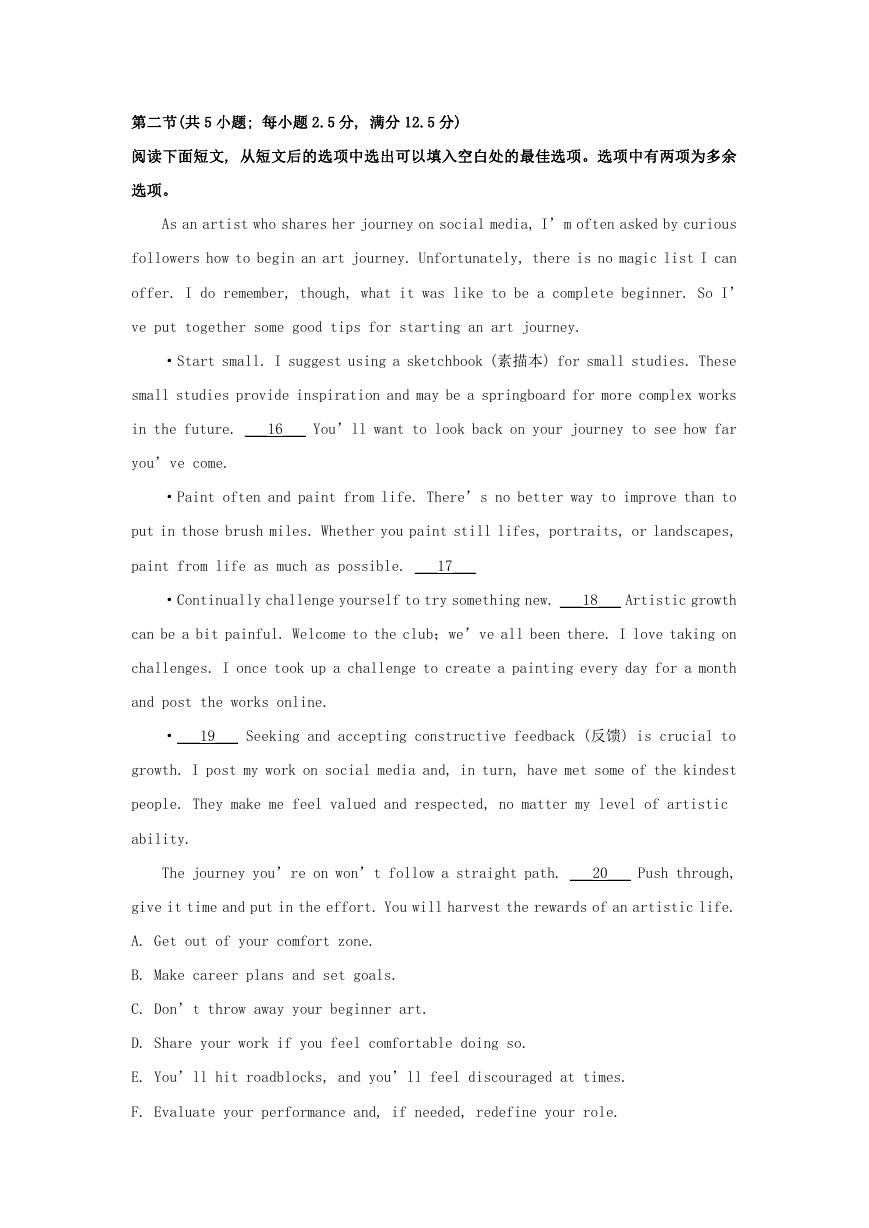
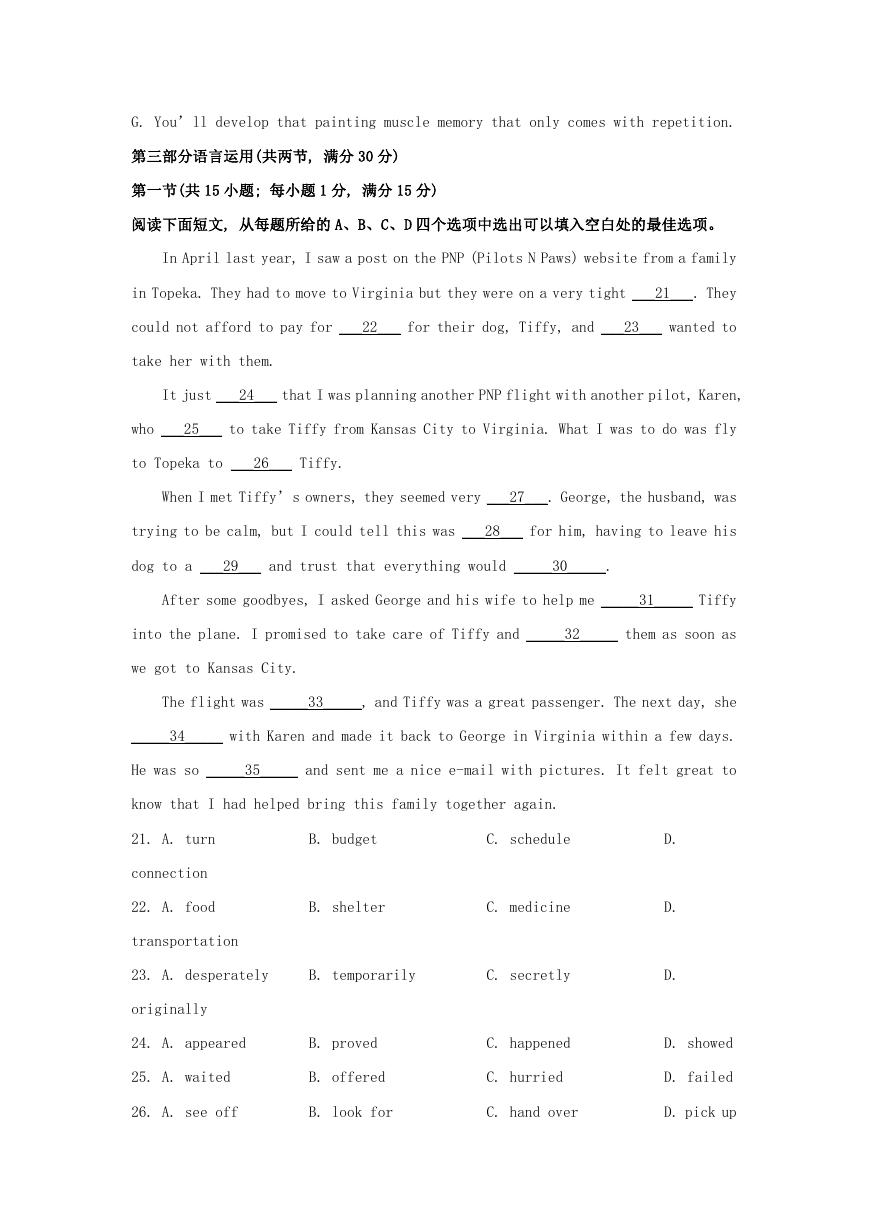








 2023年江西萍乡中考道德与法治真题及答案.doc
2023年江西萍乡中考道德与法治真题及答案.doc 2012年重庆南川中考生物真题及答案.doc
2012年重庆南川中考生物真题及答案.doc 2013年江西师范大学地理学综合及文艺理论基础考研真题.doc
2013年江西师范大学地理学综合及文艺理论基础考研真题.doc 2020年四川甘孜小升初语文真题及答案I卷.doc
2020年四川甘孜小升初语文真题及答案I卷.doc 2020年注册岩土工程师专业基础考试真题及答案.doc
2020年注册岩土工程师专业基础考试真题及答案.doc 2023-2024学年福建省厦门市九年级上学期数学月考试题及答案.doc
2023-2024学年福建省厦门市九年级上学期数学月考试题及答案.doc 2021-2022学年辽宁省沈阳市大东区九年级上学期语文期末试题及答案.doc
2021-2022学年辽宁省沈阳市大东区九年级上学期语文期末试题及答案.doc 2022-2023学年北京东城区初三第一学期物理期末试卷及答案.doc
2022-2023学年北京东城区初三第一学期物理期末试卷及答案.doc 2018上半年江西教师资格初中地理学科知识与教学能力真题及答案.doc
2018上半年江西教师资格初中地理学科知识与教学能力真题及答案.doc 2012年河北国家公务员申论考试真题及答案-省级.doc
2012年河北国家公务员申论考试真题及答案-省级.doc 2020-2021学年江苏省扬州市江都区邵樊片九年级上学期数学第一次质量检测试题及答案.doc
2020-2021学年江苏省扬州市江都区邵樊片九年级上学期数学第一次质量检测试题及答案.doc 2022下半年黑龙江教师资格证中学综合素质真题及答案.doc
2022下半年黑龙江教师资格证中学综合素质真题及答案.doc